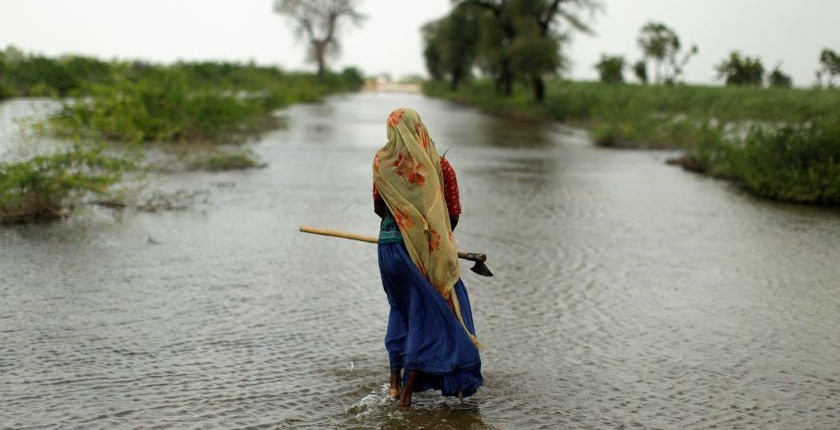
Photo: Development Canada
The catastrophic scale of the floods that have swept through Pakistan has directly endangered more than 33 million people, while nearly a third of the country is flooded. In the monsoon rains that have wreaked havoc across the country since June, over a thousand people have died. Pakistan is currently suffering the devastating effects of climate change, while catastrophes and the share of greenhouse gas emissions from this country raise questions about global solidarity, but also about the responsibility of the largest emitters of greenhouse gases that affect the incidence of climate extremes across the planet.
The number of people killed in the floods in Pakistan exceeded a thousand, while more than 33 million people have been displaced by the devastating monsoon rains that continue to cause catastrophic floods this summer.
Officials have declared a state of emergency, and Pakistani Climate Change Minister Sherry Rehman points out that the country currently does not need measures to mitigate climate change, but an urgent adaptation to such climatic extremes.
Rehman says the floods are a climate disaster, and everything looks “like a big ocean.” The economic costs are also devastating, she adds.
Pakistan is responsible for less than one percent of global emissions, but the nation with a population of 220 million ranks eighth among the countries most exposed to extreme weather.
The situation is a living example of all the crises that can erupt, warned Joudat Ayaz of Pakistan’s climate change ministry.
He stressed that attention should be paid to historical emissions as climate change like this was created by big polluting countries and emissions in the past.
“I am not satisfied with the financial and technical assistance we got from these developed countries,” Ayaz told Gwadar Pro, adding that the developed countries of Western Europe and North America are not keeping their promises.
One-third of the country is underwater
Annual monsoon rainfall is necessary for crop irrigation and the accumulation of lakes and dams on the Indian subcontinent. But they can also be devastating. This summer, rainfall has been several times the average for the monsoon period.
Also, there has been three times as many floods from glacial lakes as usual. Heat in the south exceeds 50 degrees Celsius, while forest fires are common in the west.
https://twitter.com/TheCynicalHun/status/1564208073023328256?s=20&t=GdHBumTzM-FSrqPTHdfT9Q
The provinces of Balochistan and Sindh are the hardest-hit areas. In Padidan, a town in the province of Sindh, over 1,200 mm of rain has fallen since June. Millions of hectares of rich farmland are flooded, water is tearing down dams and bridges, and the Indus river threatens to burst out of the riverbed.
Outside the polar regions, Pakistan has the biggest number of glaciers in the world. As a result of global warming, rapidly melting glaciers have created over three thousand glacial lakes in the northern provinces, threatening to burst at any moment.
Helicopters are trying to find dry land to deliver relief to people stuck in the floods. The government has declared a state of emergency, and the UN is announcing the collection of USD 160 million in aid, Pakistani officials said.
Historical emissions
According to the Carbon Brief analysis, historical emissions and the cumulative amount of carbon dioxide (CO2) emitted since the beginning of the industrial revolution are closely related to the 1.2 degrees Celsius warming that has already occurred.
From 1850 until today, about 2,500 billion tones of CO2 (GtCO2) have been emitted into the atmosphere. The biggest emitter is the United States, which accounts for the largest share, of about 20%, of these historical emissions.
Although major polluters have significantly reduced greenhouse gas emissions in recent decades, these historic emissions remain today among the most important factors contributing to global warming.
Climate disaster, global responsibility
Those regions and countries of the world that are currently the most affected by climate change are the least responsible for the climate crisis. If the principle of climate justice were to be established, these countries and regions should receive reparations for the consequences of climate change, not just first aid to survive floods or droughts.
The people of Pakistan need urgent international assistance, and it should not come in the form of aid or charitable actions, but in the form of reparations for climate damage, which would be taken over by elites and corporations that control and profit from fossil capital, says Jason Hickel, a professor at the Institute of Environmental Science and Technology (ICTA-UAB) in Barcelona.
International aid should come in the form of reparations for climate damage, which would be taken over by elites and corporations that control and profit from fossil capital
The question is how late the world is with the mitigation of climate change if the impacts of the climate crisis are so severe and present in the regions of the world. Referring first aid, food, and medicines, declaring places endangered zones and welcoming the population as climate refugees is one of the scenarios.
But this does not yet include questioning responsibilities, reparations, and support to enable vulnerable countries and regions to fight and face the climate crisis and adapt to climate change.
Khairpur by boat. Most of Sindh is under water.The crops are gone,lives ruined, livelihoods wiped out, roads swept away, houses destroyed or barely standing. The Navy is also deployed in inland Sindh and Balochistan.Where to pump/drain the water? There’s water everywhere. ?? pic.twitter.com/CuaIaP6hNH
— SenatorSherryRehman (@sherryrehman) August 29, 2022
Science has found that the combustion of fossil fuels and the emission of gases warms the planet’s atmosphere, causing extreme weather conditions, such as droughts and floods, to be more frequent and intense.
More than 800 million people on the Indian subcontinent will be directly exposed to climate change over the next few decades, due to melting glaciers and disruptions in the monsoon rains cycle, according to estimates by climate scientists.


















Be the first one to comment on this article.